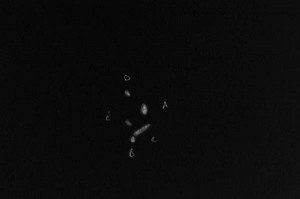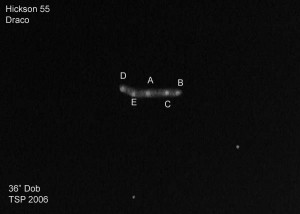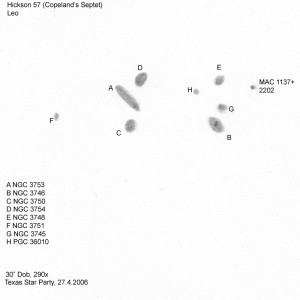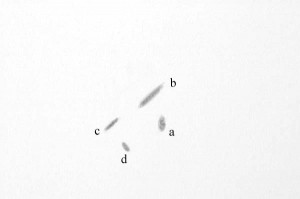In 1994, Canadian astronomer Paul Hickson published his Atlas of Compact Groups of Galaxies and it didn’t take long for these to become favourite targets of serious deep sky observers with access to moderate or large telescopes. There are 100 Hickson galaxy groups, which range from quite bright ‘eye candy’ (Hickson 44) to faint and challenging (Hickson 50). Like many amateurs before me, I have embarked on a project to see as many of these as possible. I got a head start during my visits to the Texas Star Party, where I had access to huge telescopes in the 30″ to 36″ range, but I have also seen some from my reasonably dark back garden here at home, using my 12″ f/5 and 18″ f/4.5 dobs.
I haven’t observed very many of these to date, but I plan to update this page with observations and sketches as I make them. By the end of the summer (2011), I will have an 18″ f/4.5 scope, which will be an improvement over my current 12″ f/5 when it comes to hunting down and seeing faint objects, and a fair few of the Hicksons are quite faint, or at least their component galaxies are.
For all sketches, click for a larger version. Where I don’t have a sketch, I’ve included a MegaStar generated chart of the group.
40A = MCG-1-25-9 Elliptical, with brighter centre
40B = MCG-1-25-10 Small, bright and round, with brighter centre
40C = MCG-1-25-8 Edge on, fainter than A and B. Elongated NW-SE
40D = MCG-1-25-12 Fairly bright, elongated NE-SW
40E = MCG-1-25-11 Faint, small and round
30″ Starmaster Dobsonian, magnification unknown. Ft. Davis, TX, USA, April 2006.
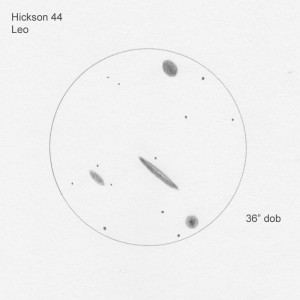 Hickson 44 – sketch made at the 2008 TSP. Description, above, was an observation made from home.
Hickson 44 – sketch made at the 2008 TSP. Description, above, was an observation made from home.
Hickson 44 – Easily located in the head of Leo, this is eye candy for a Hickson! Three are visible at low power (69x) while all four are visible at higher power (190x). At 190x they all fit nicely into the field of view (31′)
44A (NGC 3190/Arp 316) is the brightest member of the group. Oval with a nice dust lane on the south side of the galaxy seen at 190x. 3190 is a peculiar galaxy, Arp 316
44B (NGC 3193) is a round and bright even glow located next to a mag 9 star.
44C (NGC 3185) is oval and quite faint.
44D (NGC 3187) is the dimmest member of the group at mag13.4v. Elongated streak of light just east of 44A.
12” f/5 dob, 69x, 190x – Sandown, Isle of Wight, UK. NELM 6.0, Seeing I (excellent); Transparency: Very good
Hickson 55 – Using Larry Mitchell’s 36 inch dob at the 2006 TSP, I had a good look at these. They were faint but obvious. The galaxies showed up as an uneven chain of 5 tiny nuclei surrounded by a faint halo. 36” f/5 dob, magnification unknown.
55A = MCG+12-11-28A
55B = MCG+12-11-28B
55C = MCG+12-11-28C
55D = MCG+12-11-28D
55E = MCG+12-11-28E
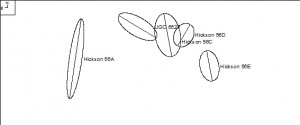 Hickson 56 – Just south of NGC 3718 this is a small faint group. With averted vision and plenty of looking, components 56B (UGC 6527), 56C (PGC 35618; the brightest member at mag 14.8v) and 56D (PGC 35615) all seen as an elongated area of brightening. 56A (MCG+9-19-113) and 56E (PGC 35609) were not seen.
Hickson 56 – Just south of NGC 3718 this is a small faint group. With averted vision and plenty of looking, components 56B (UGC 6527), 56C (PGC 35618; the brightest member at mag 14.8v) and 56D (PGC 35615) all seen as an elongated area of brightening. 56A (MCG+9-19-113) and 56E (PGC 35609) were not seen.
12” f/5 dob, 190x, 304x. Sandown, Isle of Wight, UK. NELM 6.0, Seeing I (excellent); Transparency: Very good
Hickson 57 (Copeland’s Septet)
57A = NGC 3753 Oval with brighter centre, elongated ESE-WNW
57B = NGC 3746 Faint and small. Elongated.
57C = NGC 3750 Small, round and faint
57D = NGC 3754 Small and faint, round with brighter core
57E = NGC 3748 Small, round and faint with brighter core
57F = NGC 3751 Also small, round and faint with brighter core
57G = NGC 3745 Small, round, faint.
57H = PGC 36010 Tiny, very faint, needs averted vision to see properly.
30″ Starmaster Dob, Ft. Davis, TX, USA. April 2006.
Hickson 61
61A = NGC 4169 Bright and elongated NNW-SSE, with brighter nucleus
61B = NGC 4170 Bright and elongated NW-SE, uniformly bright
61C = NGC 4175 Bright and elongated NW-SE with a very bright, stellar core.
61D = NGC 4174 Very bright, elongated NE-SW. Uniformly bright, with no central brightening.
30″ Starmaster Dob, Ft. Davis, TX, USA. April 2006.
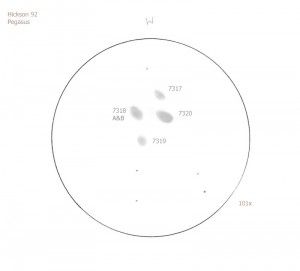 Hickson 92 – sketch made from back yard at home. 12″ f/5 dob.
Hickson 92 – sketch made from back yard at home. 12″ f/5 dob.
Hickson 92 (Stephan’s Quintet) – Seeing these depends very much on transparency. If the transparency is even slightly less than perfect, this cute little group will vanish like smoke. It is a short star hop just south west of NGC 7331.
Through the 12″ the group was faint and I saw the five (if NGC 7318A and B are counted as two and not one) members with averted vision, two reasonably ‘bright’ and the others fainter. These were NGC 7317, NGC 7318 A/7318B, NGC 7319, NGC 7320. I put the magnification up to 190x to darken the sky and this paid off with a better view of the group.
12″ f/5 dob, 61x, 190x, 304x. Sandown, Isle of Wight, UK. NELM 6.0, Seeing I (excellent); Transparency: Very good
To be continued…
References:
Cash, Ray: Observing Paul Hickson’s Catalog of Compact Groups of Galaxies
Hickson, Paul: Atlas of Compact Groups of Galaxies, Gordon and Breach Science Publishers, Basel, Switzerland, 1994.
Huey, Alvin H. At the Eyepiece Observer’s Guides: Hickson Group Observer’s Guide (1st edn), Folsom, California, USA, 2005. 2nd edition is available from Alvin here.
McGown, Robert and Paul, Miles: Galaxy Groups and Clusters: A Visual and CCD Observing Guide for the Advanced Amateur Astronomer, The Astronomical League, 1991.
Shields, Jim: 32 Interesting Hickson Groups. Adventures in Deep Space
